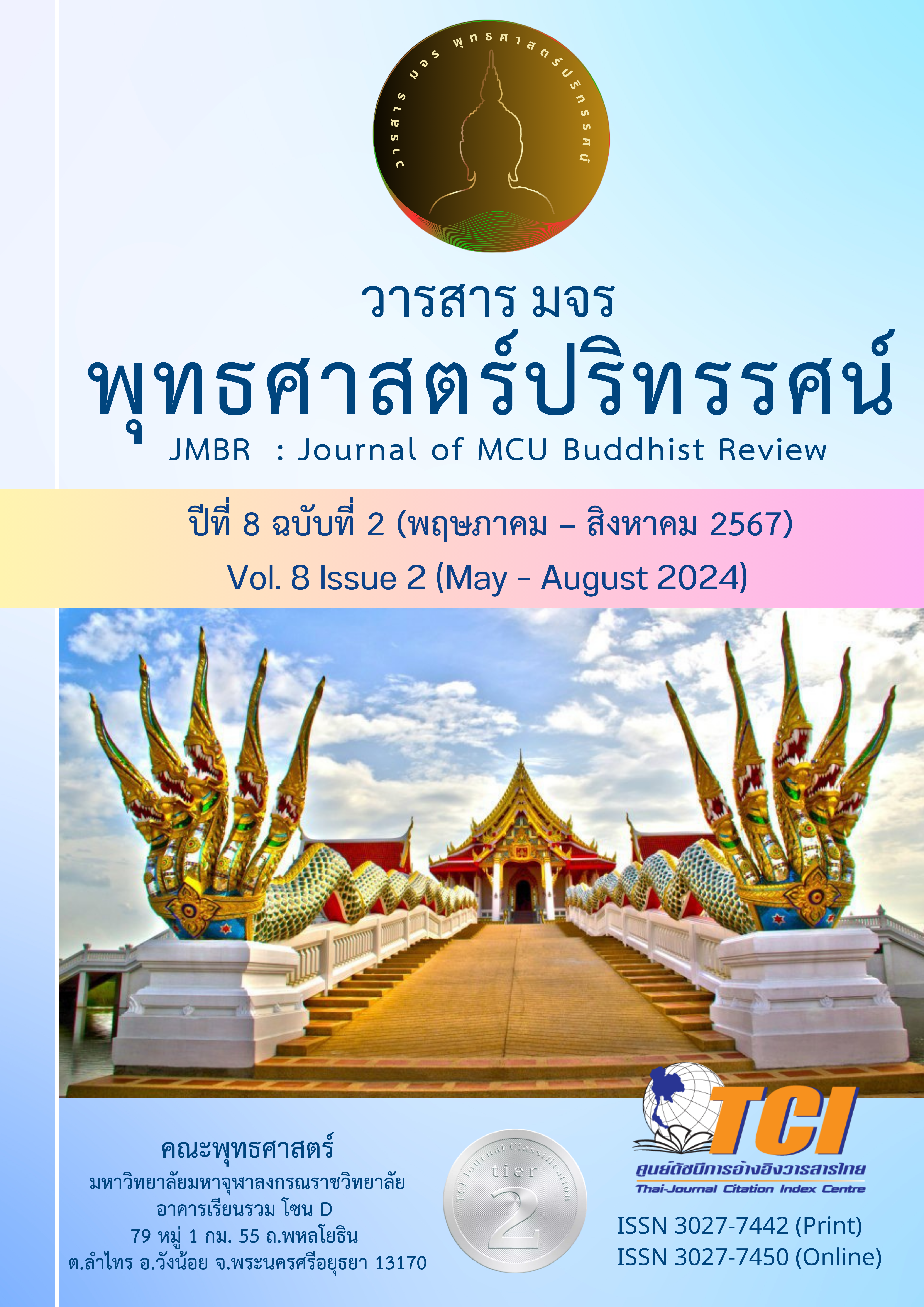ศึกษาวิเคราะห์อุบายระงับความเศร้าโศกในสัลลสูตร
Main Article Content
บทคัดย่อ
บทความวิจัยนี้ มีวัตถุประสงค์ 1) เพื่อศึกษาอุบายระงับความเศร้าโศกในพระไตรปิฎก 2) เพื่อศึกษาโครงสร้างและสาระสำคัญของสัลลสูตร 3) เพื่อวิเคราะห์อุบายระงับความเศร้าโศกในสัลลสูตร เป็นงานวิจัยเชิงเอกสาร วิเคราะห์และนำเสนอเชิงพรรณนา
ผลการวิจัยพบว่า 1) ในพระไตรปิฎก กล่าวเรื่องความเศร้าโศกจากการสูญเสียบุคคลอันเป็นที่รัก สอนให้รู้จักความจริง อันเป็นเรื่องธรรมดาของธรรมชาติ ซึ่งในสมัยพุทธกาลพระพุทธองค์ได้นำพุทธอุบายมาระงับความเศร้าโศกจากการสูญเสีย เช่น นางปฏาจาราที่สูญเสียบุคคลในครอบครัว, นางกิสาโคตมีที่สูญเสียบุตร เป็นต้น ท่านทรงใช้ธรรมเป็นเครื่องชโลมใจ
ให้บรรเทาความเศร้าโศก และนำหลักธรรมมาระงับความเศร้าโศก เช่น การเจริญสติด้วยมรณานุสติ, อภิณหปัจจเวกขณ์,
ไตรลักษณ์, อริยสัจ เป็นต้น 2) สัลลสูตร เป็นพระสูตรว่าด้วยเรื่องราวของอุบาสกท่านหนึ่ง ที่เกิดความเศร้าโศกเนื่องจากบุตรชายของตนได้สิ้นชีวิตลง พระผู้มีพระภาคจึงตรัสพระสูตรนี้ว่า ชีวิตของสัตว์ทั้งหลายในโลกนี้ ดำเนินไปสู่ความตายทุกขณะ ไม่มีใครหนีพ้นความตายได้ การเศร้าโศกเสียใจถึงบุคคลที่ตายไปแล้ว ไม่ก่อให้เกิดประโยชน์ใด ๆ มีแต่เพิ่มทุกข์ทำร้ายกายและจิตใจ บุคคลผู้มีปัญญา พึงถอนลูกศรคือกิเลสของตน ระงับความเศร้าโศก จงมีปัญญาเห็นแจ้งตามความเป็นจริง รู้เท่าทันธรรมดา 3) วิเคราะห์เกี่ยวกับการสูญเสียบุคลลอันเป็นที่รัก และการใช้อุบายระงับความเศร้าโศก ด้วยโยนิโสมนสิการ ประกอบหลักธรรมไตรลักษณ์ และอริยสัจ โดยมีเป้าหมายเพื่อกำจัดและระงับความเศร้าโศกจากการสูญเสียบุคคลอันเป็นที่รัก
Article Details

อนุญาตภายใต้เงื่อนไข Creative Commons Attribution-NonCommercial-NoDerivatives 4.0 International License.
- บทความที่ได้รับการตีพิมพ์เป็นลิขสิทธิ์ของวารสาร มจร พุทธศาสตร์ปริทรรศน์
- ข้อความใดๆ ที่ปรากฎในบทความที่ได้รับการตีพิมพ์ในวารสาร ถือเป็นความรับผิดชอบของผู้เขียนบทความ และข้อคิดเห็นนั้นไม่ถือว่าเป็นทัศนะและความรับผิดชอบของกองบรรณาธิการวารสาร มจร พุทธศาสตร์ปริทรรศน์
เอกสารอ้างอิง
กัญกร คำพรรณ์ และสิริวัฒน์ ศรีเครือดง. (2564). พุทธจิตวิทยาเพื่อการฟื้นฟูพลังจิตใจผู้ผิดหวังในความรัก. วารสาร มจร.
มนุษยศาสตร์ปริทรรศน์, 7(2), 290-307.
พระครูวิธูรธรรมวิมล (ธเนศ อมโล). (2561). ศึกษามรณสติเพื่อการพัฒนาชีวิต. วิทยานิพนธ์พุทธศาสตรมหาบัณฑิต บัณฑิตวิทยาลัย: มหาวิทยาลัยมหาจุฬาลงกรณราชวิทยาลัย.
พระปณต คุณวฑฺโฒ (อิสรสกุล). (2553). ผลของกิจกรรมเชิงพุทธที่เน้นธรรมะเรื่องหลักกรรมและชีวิตหลังความตายต่อความเศร้าโศก ของผู้เคยสูญเสียบุคคลอันเป็นที่รัก. วิทยานิพนธ์พุทธศาสตรมหาบัณฑิต บัณฑิตวิทยาลัย: มหาวิทยาลัยมหาจุฬาลงกรณราชวิทยาลัย.
พระพรหมคุณาภรณ์ (ป.อ. ปยุตฺโต). (2556). โยนิโสมนสิการ วิธีคิดตามหลักพุทธธรรม. พุทธธรรม ฉบับปรับขยาย บทที่ 13. พิมพ์แยกเล่มเฉพาะบท ครั้งที่ 1. ฉบับข้อมูลคอมพิวเตอร์.
พระพรหมคุณาภรณ์ (ป.อ.ปยุตฺโต). (2558). พจนานุกรมพุทธศาสน์ ฉบับประมวลศัพท์. พิมพ์ครั้งที่ 24. กรุงเทพมหานคร: สำนักพิมพ์ผลิธัมม์ ในเครือ บริษัท สำนักพิมพ์เพ็ทแอนด์โฮม จำกัด.
พระพรหมคุณาภรณ์ (ป.อ. ปยุตฺโต). (2558). พจนานุกรมพุทธศาสตร์ ฉบับประมวลธรรม. พิมพ์ครั้งที่ 31. กรุงเทพมหานคร: สำนักพิมพ์ผลิธัมม์ ในเครือ บริษัท สำนักพิมพ์เพ็ทแอนด์โฮม จำกัด.
พอศรี อินดี. (2555). พุทธวิธีการแก้ปัญหาความทุกข์ที่เกิดจากการพลัดพราก. วิทยานิพนธ์พุทธศาสตรมหาบัณฑิต สาขาวิชาพระพุทธศาสนา. บัณฑิตวิทยาลัย: มหาวิทยาลัยมหาจุฬาลงกรณราชวิทยาลัย.
มหาจุฬาลงกรณราชวิทยาลัย. (2539). พระไตรปิฎกภาษาไทย ฉบับมหาจุฬาลงกรณราชวิทยาลัย. กรุงเทพฯ: โรงพิมพ์มหาจุฬาลงกรณราชวิทยาลัย.
มหาจุฬาลงกรณราชวิทยาลัย. (2556). อรรถกถาภาษาไทย ฉบับมหาจุฬาลงกรณราชวิทยาลัย. กรุงเทพฯ: โรงพิมพ์มหาจุฬา
ลงกรณราชวิทยาลัย.
อธิเทพ ผาทา ดร. (2552). กุศโลบาย : ศึกษาการใช้ปัญญาเพื่อการแก้ไขปัญหาที่ปรากฏในคัมภีร์พระพุทธศาสนาเถรวาท. รายงานการวิจัย สถาบันวิจัยพุทธศาสตร์ มหาวิทยาลัยมหาจุฬาลงกรณราชวิทยาลัย.
อารยา บัตรเจริญ. (2563). ศึกษาวิเคราะห์หลักพุทธธรรมเพื่อการบรรเทาความทุกข์ในใจ. วิทยานิพนธ์ศาสนศาสตรมหาบัณฑิต บัณฑิตวิทยาลัย: มหาวิทยาลัยมหามกุฎราชวิทยาลัย.

